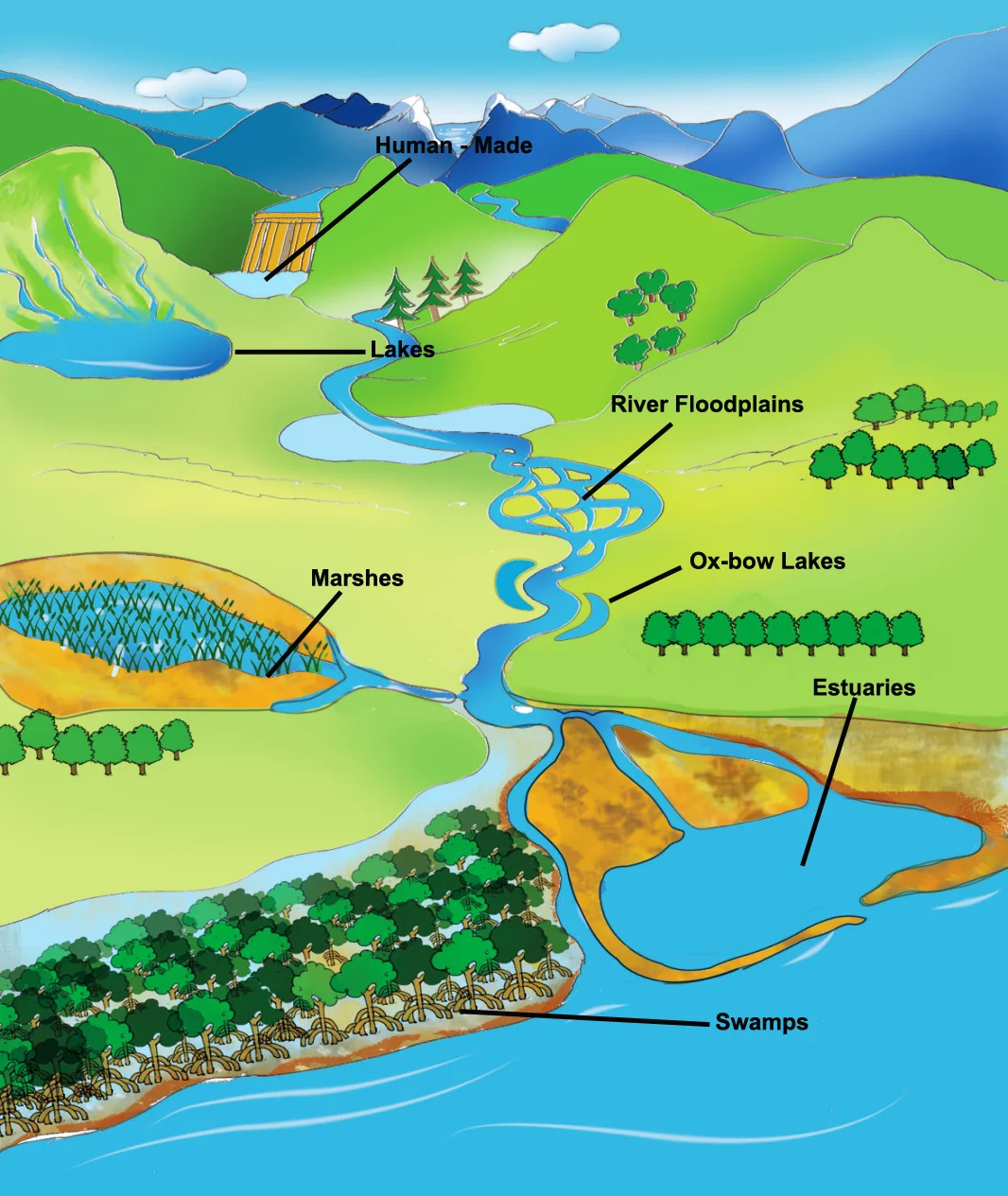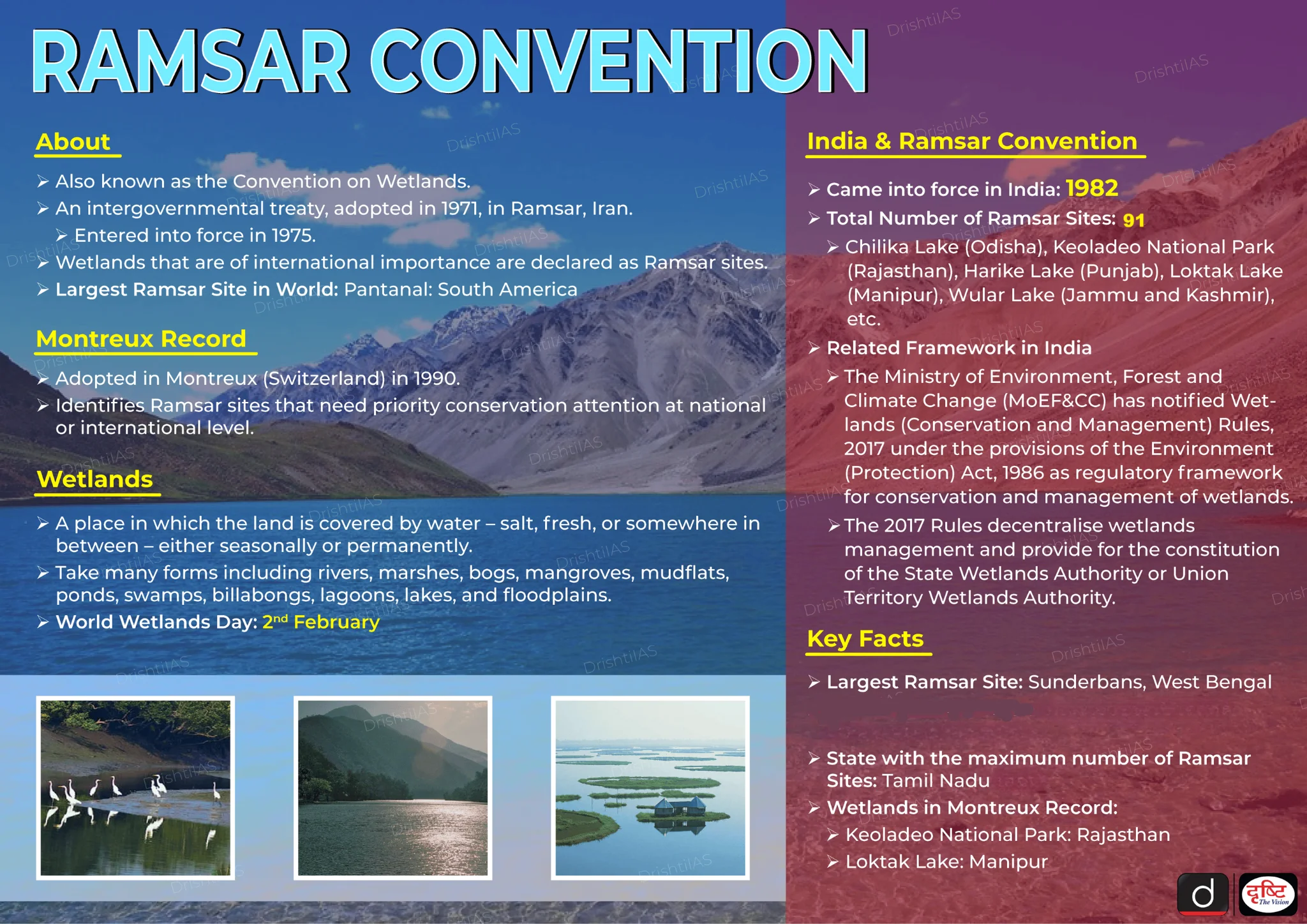Global Wetland Outlook 2025 | 22 Jul 2025
For Prelims: Ramsar Convention, International Union for Conservation of Nature, Kunming-Montreal Global Biodiversity Framework, Sustainable Development Goals
For Mains: Ramsar Convention and India’s commitments, Role of wetlands in achieving SDGs
Why in News?
The Global Wetland Outlook (GWO) 2025, released by the Secretariat of the Ramsar Convention (1971), highlights that Africa’s wetlands are among the most degraded in the world.
Note: The Ramsar Convention Secretariat is based in Gland, Switzerland. The International Union for Conservation of Nature (IUCN) supports its operations by providing administrative services to the Convention’s member countries.
What are the Key Takeaways from Global Wetland Outlook 2025?
- Global Wetland Coverage: Wetlands (Seagrass, Kelp Forests, Coral Reefs, Estuarine Waters, Salt Marshes, Mangroves, Tidal Flats, Lakes, Rivers and Streams, Inland Marshes and Swamps, and Peatlands) cover over 1,800 million hectares globally, including inland freshwater, coastal, and marine ecosystems.
- However, data uncertainty persists due to inconsistent methods and gaps in historical data.
- Loss and Degradation: Since 1970, the world has lost about 411 million hectares of wetlands, marking a 22% global decline at an average annual loss rate of -0.52%.
- Wetlands in Africa, Latin America, and the Caribbean are facing the worst levels of degradation, but ecological deterioration is also rising in Europe, North America, and Oceania.
- Wetlands are in the worst condition in Least Developed Countries (LDCs). In upper-middle-income and developed countries, more wetlands are reported in good condition than poor.
- Value of Wetlands: Wetlands provide food, water filtration, disaster protection, carbon storage, and cultural value.
- The ecosystem service value of global wetlands is estimated at USD 39 trillion. Wetlands make up just 6% of Earth's surface but deliver ~7.5% of global GDP in value.
- Over 60% of GDP in some African countries comes from nature-based sectors. Wetland loss increases climate risks and lowers productivity. Investing in wetlands is a smart, cost-effective step toward sustainable growth.
- Wetland Funding Gap: Biodiversity funding is just 0.25% of global GDP, far too low to meet current needs.
- Recommendations:
- Wetland Conservation: It calls for urgent action to align with the Kunming-Montreal Global Biodiversity Framework (KM-GBF), particularly Target 2 (restoring at least 30% of all degraded ecosystems) and Target 3 (conserving at least 30% of land, waters, and seas).
- To meet these goals, around 123 million hectares of wetlands must be restored, possibly exceeding 350 million hectares if degraded wetlands are included.
- Additionally, about 428 million hectares need to be effectively managed through protected areas or conservation measures.
- This effort supports climate goals under the UN Framework Convention on Climate Change (UNFCCC), Sustainable Development Goal 6.6 on water ecosystems.
- Conservation Over Costly Restoration: Conserving healthy wetlands is far cheaper than restoring degraded ones, which can cost anywhere from USD 1,000 to over USD 70,000 per hectare annually.
- Boost Investment in Nature-Based Solutions (NbS): Encourage both government and private sectors to invest in wetland protection as cost-effective NbS for disaster resilience, climate mitigation, and water security.
- Build capacity and long-term strategies to scale up wetland investments globally.
- Wetland Conservation: It calls for urgent action to align with the Kunming-Montreal Global Biodiversity Framework (KM-GBF), particularly Target 2 (restoring at least 30% of all degraded ecosystems) and Target 3 (conserving at least 30% of land, waters, and seas).
What are Wetlands?
- About: The Ramsar Convention defines wetlands as areas of marsh, fen, peatland, or water natural or artificial, permanent or temporary with static or flowing water that may be fresh, brackish, or salty, including shallow marine areas up to six meters deep at low tide.
- It also allows inclusion of nearby riparian or coastal zones and deeper marine areas if they lie within the wetland system.
- Major Types of Wetlands:
- Human-made Wetlands: Built for purposes like irrigation, drinking water, fish farming, or recreation. Examples include reservoirs, aquaculture ponds, salt pans, dams, and barrages.
- Nagi and Nakti Bird Sanctuaries in Bihar, now Ramsar Sites, are human-made wetlands created for irrigation via the Nakti Dam.
- Lakes and Ponds: Inland freshwater bodies that support diverse plant and animal life.
- River Floodplains: Low-lying areas next to rivers that flood periodically. The Yamuna floodplains, for instance, are Delhi’s key water source.
- Bakhira Wildlife Sanctuary is a floodplain wetland in Uttar Pradesh, with the Rapti River flowing through it.
- Oxbow Lakes: Crescent-shaped waterbodies formed when river meanders are cut off due to silt or course change.
- Common in the Ganga, Brahmaputra, and Mahanadi basins (e.g., Ansupa Lake).
- Kanwar Lake, Bihar (also known locally as Kabartal) is Asia’s largest freshwater oxbow lake.
- Marshes: Wetlands with herbaceous plants, fed by sources like runoff, groundwater, or tides. Example: Kanwar Jheel in Bihar.
- Estuaries: Brackish water zones where rivers meet the sea, like the Chilika Lagoon in Odisha. Coastal lagoons form when sandbars separate sea and river water.
- Swamps: Tree-dominated wetlands with waterlogged soil. Mangroves are coastal swamps. Sunderbans is the largest mangrove swamp in the world.
- Human-made Wetlands: Built for purposes like irrigation, drinking water, fish farming, or recreation. Examples include reservoirs, aquaculture ponds, salt pans, dams, and barrages.
- Ecosystem Services of Wetlands:
- Water Purification: Wetlands act as kidneys of the habitat by purifying water, sequestering huge amounts of carbon (thereby mitigating climate change) and , supporting irrigation, and improving both surface and groundwater quality.
- Storm Protection: Coastal wetlands like mangroves and salt marshes reduce storm surges, flooding, and erosion.
- Flood Control: Absorb excess water during storms, reducing downstream floods and supporting streamflow in drought. Mangroves can lower flood depths by 15–20%, and up to 70% during major storms.
- Erosion Control: Wetland plants stabilize soil and prevent streambank erosion.
- Wildlife Habitat: Wetlands are ecotones rich in both aquatic and terrestrial life, supporting amphibians, birds like ducks and cranes, mammals, and migratory species.
- Wetlands support spawning, feeding, and nursery areas for species like trout, crab, and shrimp.
- High Productivity: Some wetlands (e.g. salt marshes) produce more biomass per acre than most crops.
- Education: Serve as natural classrooms for ecological and cultural learning.
- Status of Wetlands in India: As of August 2024, India has 1,307 identified wetlands covering over 1.35 million hectares, the highest wetland coverage in South Asia.
- Efforts to Conserve Wetlands:
- Ramsar Convention: India ratified the Ramsar Convention in 1982, naming Keoladeo National Park and Chilika Lake as its first two Ramsar Sites. With Khichan and Menar in Rajasthan added in 2025, India now has 91 Ramsar Sites, showing its continued focus on wetland conservation.
- The Montreux Record is a list of Wetlands of International Importance under the Ramsar Convention that are facing, or are likely to face, ecological damage.
- India currently has two wetlands on the Montreux Record: Keoladeo National Park in Rajasthan and Loktak Lake in Manipur.
- Wetlands of India Portal (2021): Provides public access to wetland data, maps, and conservation updates.
- National Wetland Decadal Change Atlas: Tracks changes in wetlands using satellite data.
- Amrit Dharohar Scheme (2023): Focuses on eco-tourism, community income, biodiversity enhancement, and carbon storage in wetlands.
- Integration with Namami Gange: Aligns wetland conservation with river basin management, especially in the Ganga basin.
- World Wetlands Day: Observed on 2nd February to mark the adoption of the Ramsar Convention on Wetlands in 1971 in Ramsar, Iran.
- Ramsar Convention: India ratified the Ramsar Convention in 1982, naming Keoladeo National Park and Chilika Lake as its first two Ramsar Sites. With Khichan and Menar in Rajasthan added in 2025, India now has 91 Ramsar Sites, showing its continued focus on wetland conservation.
|
Drishti Mains Question: Discuss the ecological and economic importance of wetlands. |
UPSC Civil Services Examination Previous Year Question (PYQ)
Q. If a wetland of international importance is brought under the ‘Montreux Record’, what does it imply?(2014)
(a) Changes in ecological character have occurred, are occurring or are likely to occur in the wetland as a result of human interference
(b) The country in which the wetland is located should enact a law to prohibit any human activity within five kilometres from the edge of the wetland
(c) The survival of the wetland depends on the cultural practices and traditions of certain communities living in its vicinity and therefore the cultural diversity therein should not be destroyed
(d) It is given the status of ‘World Heritage Site’
Ans: (a)


